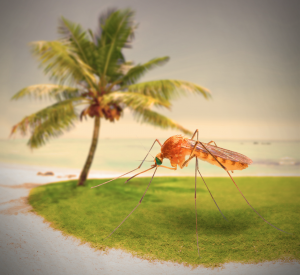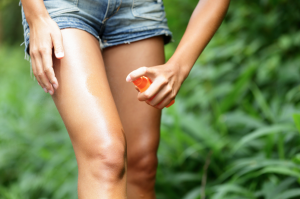Only the female “little flies”, the mosca-itos, feed on blood – they require protein to make eggs. For energy, both sexes rely on the carb calories in nectar.
Mosquitoes on evening patrol will find you by sight and smell. They can see you perfectly well: their large compound eyes pick up the bright contrast that you might make with your surroundings, and they will easily detect your smallest movement. Mosquitoes’ antennae carry 72 types of super-sensitive nerve endings which swiftly identify your complex spoor; especially attractive is your exhaled carbon dioxide “plume” which mozzies can recognise 50 metres away. By following this vapour trail they will soon distinguish your radiant heat, and then they will unerringly lock on to your specific scent – which can be more or less attractive according to the chemistry of your sweat.
Not enough is known about human pheromones, but a number of chemicals exuded from the skin are mosquito attractants. These odorants are known to be clustered particularly around the arm-pits, elbows, forearms and ankles.
As we all know, some people attract more attention than others. The mosquito has honed its skills over a period of more than 200 million years, and by now can predict with pitch perfect accuracy which animal will provide a satisfying meal without the expenditure of valuable energy in a tasting. Being attractive (to mosquitoes) is a heritable trait and those of us (47%) with group O blood “be afraid, be very afraid”!
The mosquito’s hypodermic proboscis has two tubes – one through which it actively spits, the other through which the victim’s blood is forced by positive pressure into its abdomen. The spit prevents the blood clotting, and contains proteins which trigger an inflammatory reaction in the punctured dermis – hence the red and itchy “bite”.
Around three million people a year are killed by organisms contained in the mosquito’s spit.
Unfortunately ultra-effective and long-lasting mosquito repellents also smell utterly repugnant to us humans. The nearest to an acceptable ideal is the synthetic chemical DEET (N, N-diethyl-m-toluamide) which was developed for use by the American Army in 1944.
The Centers for Disease Control and Prevention recommendation is for the use of a 30-50% DEET solution on unclothed and undamaged skin, which should provide protection for 3 to 6 hours. Rarely, DEET can irritate the skin, eyes and lungs, and it has been reported as causing headache. DEET is safe to use on children over two months old at concentrations between 10% and 30% (American Academy of Pediatrics). Some authorities recommend the use of DEET spray on children rather than the application of the lotion.
An organic alternative to DEET is PMD (para-menthane-3, 8-diol), a by-product of the distillation of the leaves of the Australian lemon-scented gum tree (corymbia citriodora). PMD is NOT the essential oil of lemon eucalyptus, and PMD is the only registered “natural” preparation comparable in efficacy to DEET (J Am Mosq Control Assoc. 2006 Sep; 22 (3): 507-14. PMID: 17067054).
No other plant-based preparations has been legally approved as a safe and effective mosquito repellent in Europe or the United States.
Essential oils, candles, coils, electronic devices, bug lights, apps, plugs and so on must not be relied upon.
Remember that the vast majority of mosquito species are crepuscular: they only feed at twilight and just before dawn – just the time you might not be taking too much notice.
Richard Petty





